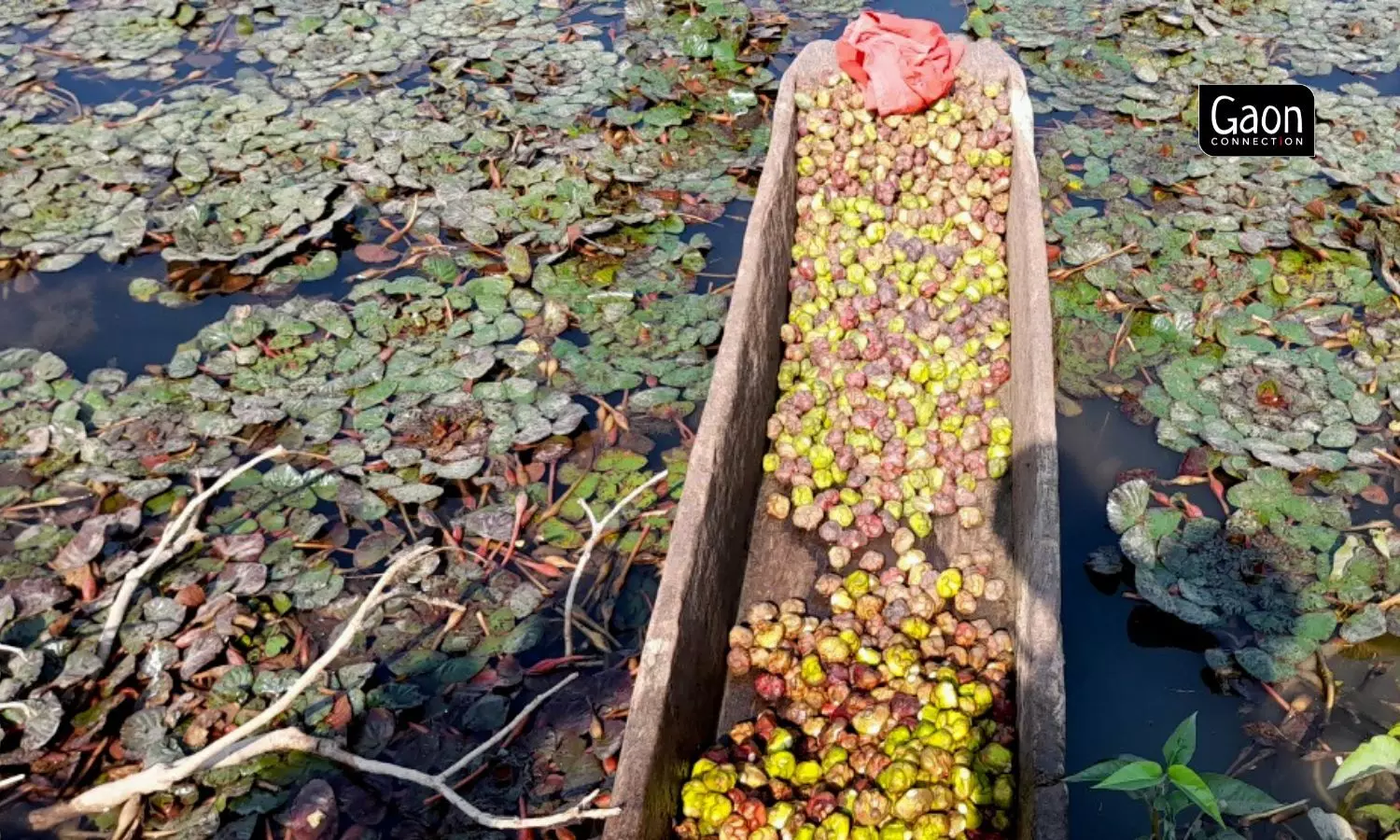A farmer grows water chestnut on land stripped of soil; earns profit, repays loans
A farmer in Kanpur district, Uttar Pradesh, has successfully grown water chestnuts on land that was stripped of its top 5-6 feet of soil. Madan Kahar is now the talk of not just his village, but several other neighbouring villages.
 Manish Dubey 13 Jan 2023 9:22 AM GMT
Manish Dubey 13 Jan 2023 9:22 AM GMT

Madan Kahar invested about Rs 50, 000 in his water chestnut crop and earned 1.75 lakh rupees from his 250 quintals of yield. Photo by Gaon Connection.
Madan Kahar leaned his bicycle against the mud wall of his home in Champatpur village of Uttar Pradesh. He was preparing to fill air into its front tyre before leaving for work.
The 45-year-old is a landless farmer, who has taken six bighas (2.40 acres) of land from Lakhan Singh, a landlord in the same village, and is growing water chestnuts on it. Champatpur village falls in Barakheda block of Kanpur district.
There is relief writ large on his face as Madan told Gaon Connection how the harvest had helped him repay part of the one lakh rupee loan he had taken for his daughter’s wedding.
“The loan lay heavily on my mind. As a landless farmer, it is a lot of money and my wife and I have three other children to look after,” Madan told Gaon Connection.
The six bighas of land Madan leased was also not the best. The landlord Lakhan Singh had sold the top five to six feet of soil from the land to a brick kiln. But Madan took the soil-less land on lease.
According to him, he has an understanding with the landlord about sharing whatever profits he makes out of his crops, as rent. He decided to grow water chestnuts, locally known as singhada .
Also Read: UP: Unnao's first women-led SHG for Thai guava cultivation promises better incomes for farmers
Madan invested about Rs 50, 000 in the crop. The seeds were sown in September and the harvest happened in December 2022. According to Madan, the land yielded about 250 quintals of singhada from which he earned 1.75 lakh rupees. He has since managed to repay part of the loan.
“In order to start the cultivation, I had to take a further loan of Rs 30, 000 from Bhoop Singh, our gram pradhan, but the good harvest has helped me repay a large part of both my loans,” he said happily. He took the loans on 6 per cent interest, he said.
For water chestnut farming, the land has to be prepared with fertilisers, and about four to five feet of water, needed for it to grow. Photo by Manish Dubey.
The reason Madan chose water chestnuts was because once harvested, it found buyers almost immediately. There was no waiting period like there was for wheat and other crops, he said.
“No one had cultivated water chestnuts in this area before. And the fact that Madan did it on land that had been stripped of its topsoil, is remarkable,” Arvind Shukla, a fellow villager and farmer, told Gaon Connection.
Madan has now become talk of not just his village, but several other villages nearby. “No one had heard of Madan before, but now there are people wanting to meet him and ask for his whereabouts,” Shukla added.
Water chestnut farming
There is a lot of hard work involved in the first round of sowing and cropping of water chestnuts, but it gets easier after that, Madan said. The land has to be prepared with fertilisers, and about four to five feet of water, needed for the water chestnuts to grow.
Also Read: The Strawberry Farmers of Odisha
The water chestnut seeds were procured from a nursery. “Preparing the seeds and checking to see that there are no pests hidden in them is a laborious process. And I have to weed regularly,” he explained.
Water chestnut, which is high in iodine and manganese, is said to be good for those having problems with their thyroid. It is also supposed to purify blood, cure coughs, reduce anaemia and is rich in antioxidants.
The seeds were sown in September and the harvest happened in December 2022. The land yielded about 250 quintals of singhada. Photo by Gaon Connection.
“I never thought anything would grow on the land after the top six feet or so of its soil had been removed,” Hari Krishan, the lekhpal (village registrar), told Gaon Connection. “But Madan proved all of us wrong. Not only did he successfully grow the singhada, he also managed to repay most of the loan he took for his daughter’s wedding,” Hari Krishan said.
agriculture Kanpur Uttar Pradesh Farmer
More Stories




